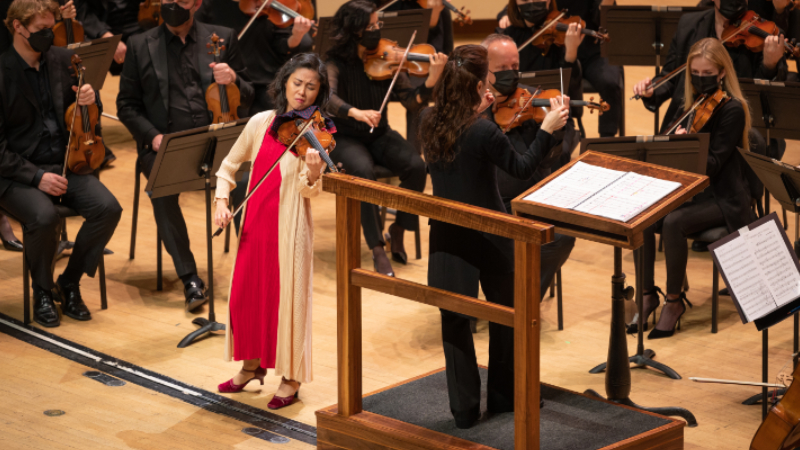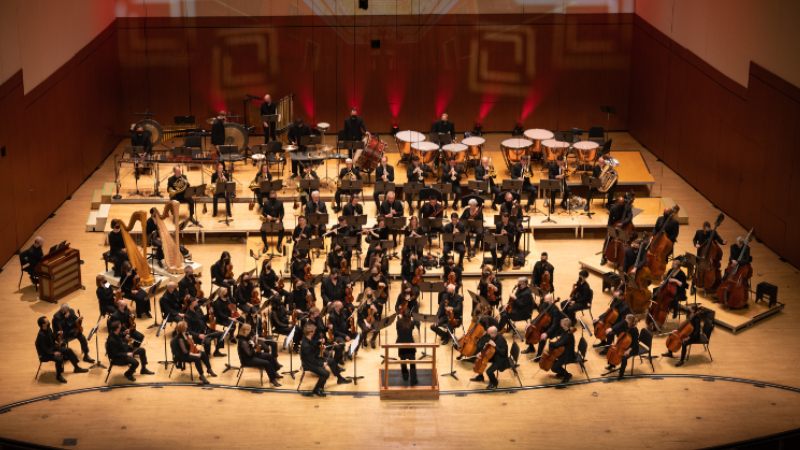February 9 & 11, 2023
Atlanta Symphony Hall, Woodruff Arts Center
Atlanta, Georgia – USA
Han-Na Chang, conductor; Sayaka Shoji, violin.
Anna CLYNE: This Midnight Hour
Sergei PROKOFIEV: Violin Concerto No. 1, Op. 19
Modest MUSSORGSKY/Ravel: Pictures at an Exhibition
Mark Gresham | 10 FEB 2023
On Thursday evening, the Atlanta Symphony Orchestra performed a concert of music by Clyne, Prokofiev, and Mussorgsky, led by Korean guest conductor Han-Na Chang and featuring Japanese violinist Sayaka Shoji.
However, the most immediately conspicuous aspect of the concert was that, aside from the wind players, the musicians of the ASO were again wearing masks, as did conductor Chang through most of the performance and as did Shoji when not playing.
The unofficial word is that last Saturday, three ASO musicians tested positive before a run-out concert at the River Center for the Performing Arts in Columbus, Georgia. While the ASO does not comment on personal health issues, a spokesperson for the orchestra relayed the following response to a query from EarRelevant: “The ASO prioritizes performing safely, and we recognize that COVID-19 and other respiratory illnesses remain a significant part of our lives. When it’s appropriate, we ask our musicians to wear masks to mitigate community spread.”
The program opened with This Midnight Hour by British composer Anna Clyne, a 2015 work co-commissioned by L’Orchestre national d’Île-de-France and the Seattle Symphony. It’s not the first time the ASO has opened a concert with Clyne’s music. The last time was in May 2022, when they performed Sound and Fury under the baton of British guest conductor Alexander Soddy. In both works, Clyne draws inspiration from sources; in the case of this 12-minute work, she says in her notes, from “the character and power of the lower strings of L’Orchestre national d’Île-de-France” and two poems: “La musica” by Juan Ramón Jiménez and “Harmonie du soir” by Charles Baudelaire.
The first inspiration is evident in the intense driving bass line at the start, which immediately sets the forward momentum in motion as well as the work’s overall tone. Clyne’s style is accessible and cinematic, a kind of restless stream of consciousness, with moods ranging from tempestuous to effusively romantic to folklorish, all colorfully scored. There was even one place where Clyne seemed to slyly hint at the tune from Smetana’s “The Moldau” at half speed. (I was not the only one to notice that.) After much thunder, with generous spaces afforded between, the music ends abruptly with a bang from the bass drum.

Violinist Sayaka Shoji performs Prokofiev’s “Violin Concerto No. 1” with conductor Han-Na Chang and the Atlanta Symphony Orchestra. (credit: Rand Lines)
Sayaka Shoji joined Cang and the ASO to perform Sergei Prokofiev’s Violin Concerto No. 1. Written in 1917, its airy modernism is a fine amalgamation of sweetness, playfulness, and spunky demeanor, featuring lyrical and ethereal aspects as well as an underlying momentum.
Shoji blended subtlety and a modest dose of passion into a musical and intelligent performance. Much like Midori, Shoji has both the musicianship and the technical chops but does not have a large, projecting sound. For that very reason, this Prokoviev concerto suits her as a vehicle, helping her sound emerge from the orchestral texture to the audience.
Modest Mussorgsky’s Pictures at an Exhibition, written in 1874, is his best-known composition for solo piano. Various transcriptions and arrangements have subsequently been produced by others, with the most famous adaptation being the 1922 orchestration by Maurice Ravel, which came after intermission.
Mussorgsky’s opening “Promenade” was stately and reserved, not rushed or strident, followed by the lurching “The Gnome” with its jerky fits of starts and stops. The second “Promenade” came across as a thoughtful walk, leading to “The Old Castle” with its almost nostalgic aura, the saxophone solo played with remarkably smooth, song-like fluidity. A third “Promenade” felt more extroverted, followed by “Tuileries” which pictures children quarreling in a public park, the Jardin des Tuileries.

ASO performs Mussorgsky’s “Pictures at an Exhibition.” (credit: Rand Lines)
In “Bydlo,” portraying a Polish ox-cart, the musicians experienced differences in tempo among themselves, so the movement never gelled into its trudging pace, and the tranquil fourth “Promenade” after seemed to lack cohesion and character. Things came back together with the next five movements, “Ballet of the Unhatched Chicks,” “Samuel Goldenberg and Schmuÿle,” “Limoges: The Marketplace (Important News!),” “Catacombs,” and”:The Hut on Fowl’s Legs (Baba Yaga).”
The “Promenade” theme returned amid the grand finale, “The Great Gate of Kiev,” which was stately if somewhat ordinary, but at least not overblown for cheap effect, which too often can happen, so we’re okay taking it on the slightly more reserved side in this case. ■
EXTERNAL LINKS:
- Atlanta Symphony Orchestra: aso.org
- Han-Na Chang: hannachangmusic.com
- Sayaka Shoji: sayakashoji.com

Read more by Mark Gresham.







.png)